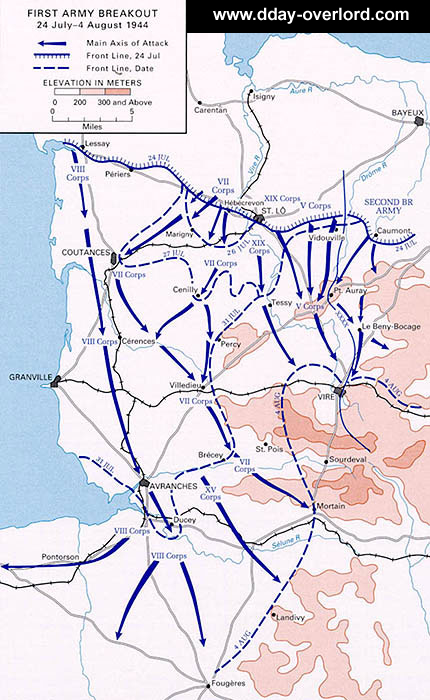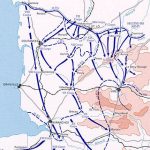- Origins of operation Cobra
A month and a half after D-Day, most of the German reinforcements in Normandy were directed towards the city of Caen. Cherbourg having fallen into the hands of the Americans, they decided to concentrate on the defense of Caen, a nerve center of the region. General Omar Bradley plans to take advantage of the strategic situation in the region to break through the front to the west of Caen and liberate Britain from the enemy occupation. Indeed, the balance of German lines is strongly in favor of the region of Caen, which concentrates most of the armored units, leaving the southern Cotentin.
The situation is nonetheless blocked for the Americans who are progressing very slowly and at the cost of heavy losses. The nature of the terrain, the Norman hedgerow, is one of the explanations for these bad results. Between The Hague-du-Puits and Lessay, they count 1,000 killed per kilometer and the only catch of Mont-Castre costs them 5,000 men. The 79th Infantry Division loses one man every three meters during the conquest of the village of Montgardon, near La-Haye-du-Puits. The weather is appalling and prevents air support from supporting the ground units, not to mention its poor impact on the morale of the allied troops.
American soldiers taking position south of La-Haye-du-Puits after the conquest of the city. Photo: US National Archives
The Allies began the development of this operation on June 13, 1944, before the capture of Cherbourg in the north of Cotentin became one of their first priorities. The idea was resumed the following month and presented to General Montgomery on 10 July. Its launch is scheduled for July 18th. At the beginning of the operation, the front line must be pierced by Major General Eddy commanding the 9th Infantry Division and Major General Hobbs commanding the 30th Infantry Division. Then the reinforcements must advance through the German lines and head west.
The Americans gather four infantry divisions and two armored divisions on a narrow corridor of only eight kilometers. These units are under the command of General Collins’ 7th Corps. Meanwhile, the British are distracting by launching several operations in the region of Caen, which focuses the attention of the Germans. While 110 tanks are facing American units in southern Cotentin, nearly 600 tanks are gathered against the Anglo-Canadian forces.
- A difficult start for Cobra
Weather conditions delay the start of operation Cobra from July 18 to 20, and then to July 24.
Map of the tactical situation during the night of 24 to 25 July 1944.
Three divisions of the 8th U.S. Air Force, that is to say nearly 1600 bombers, as well as six groups of fighter-bombers of the 9th T.A.C. (Tactical Air Combat) began bombing a narrow corridor in the early afternoon, four kilometers north-west of Saint-Lô, six kilometers long and three wide. The clouds are numerous and hamper the smooth running of the bombardment; 500 bombers choose to turn around.
In anticipation of the bombing, US forces in the area (the 9th and 30th infantry divisions) were ordered during the night of 23-24 July to retreat for a distance of 1,100 meters To the north-east. But, if time has improved, it is not yet excellent and units of the 30th Infantry Division are bombed by mistake. 25 American soldiers are killed and 131 wounded. Dozens of soldiers are buried alive by the immense sheaves of earth raised by the explosions, while the others rush to free them from this bad posture. The survivors of the 30th Division rejoin their abandoned positions during the night and observe the enemy movements.
Fighting took place because the Germans of the Panzer Lehr Division infiltrated these positions, particularly in the area of the 60th infantry regiment belonging to the 9th American Division, between the place Hauts-Vents and the Bois du Hommet, Along the road from Saint-Lô to Périers, south-west of Saint-Jean-de-Daye.
The reports of the bombardment alarm General Bradley. However, he decides to maintain the Cobra offensive for the next day.
- The most important « Carpet Bombing » of War War 2
On Tuesday, July 25, at 9:40 am, and for almost an hour, began the installation of the largest carpet bombing of the entire World War II: 1,500 B-17 and B-24 drop almost 3,300 tons of bombs between Montreuil and Hebécrevon northwest of Saint-Lô. These bombers are supported by 1,000 other medium-range aircraft and bomber-fighter aircraft: 60,000 incendiary bombs are dropped on 12 square kilometers of bocage, or 5,000 bombs per square kilometer. The ground artillery takes over: massive shelling is carried out by 1,100 pieces of artillery.
A 155 mm M114 howitzer in action near Périers. Photo: US National Archives
Again, due to bad weather and proximity to US forces, dozens of soldiers are killed by the bombing of their own units. There are 111 deaths and nearly 500 injured in the American ranks. Among the dead, the Americans learn of the death of Lieutenant General Lesley McNair, the highest American officer who died in combat on European theater.
The bombing is also disastrous for the German forces, which are losing many soldiers and vehicles: the Panzer Lehr has only seven tanks in working order in this sector. The Germans lost not only their armored support, but also about 2,500 soldiers were killed by the bombing (out of the Panzer Lehr 5,000).
The geography of the places is greatly modified by these bombardments, to the point of having inconvenient consequences for the American breakthrough itself. Indeed, the bombs have dug huge craters through the Normandy bocage, to the point of making particularly difficult the progression of the vehicles in the sector. The surrounding villages are impracticable, being transformed into heaps of ruins: as a sad example, the commune of La Chapelle-en-Juger is wiped off the map.
The Americans launched their six divisions on the attack between Montreuil and Hebecrevon, which took the following directions from west to east: the 9th Infantry Division, on the left flank of the offensive, was heading south from Montreuil And must postpone the counterattacks of the 2nd and 17th SS Panzer Division. The 1st Infantry Division attacks in the direction of Marigny and continues the German paratroopers fleeing. The 3rd Armored Division headed for Cerisy-la-Salle, the 4th Infantry advanced to Canisy. The 2nd Armored Division attacks Saint-Gilles while the troops on the east side of the 30th Infantry are heading south from Saint-Lô, attacking the 352nd Infantry Division and the 2nd Parachute Regiment.
On the evening of July 25, the front line only increased two kilometers to the south. American generals, including Bradley, are worried about this weak advance but German prisoners say they are still shocked by the power of the bombing. The Americans decided to increase the amount of bombardment for the next day.
Private Sam J. Abbot with his Browning machine gun under surveillance in a hedge of the Norman bocage. Photo: US National Archives
On the same day, the British launched operation Spring, south of Caen. This offensive, mainly led by the Canadian Black Watch Regiment, must persuade the Germans to maintain a strong force in contact with the British, instead of sending reinforcements to fight the American offensive.
![]() Back to the Allied operations menu
Back to the Allied operations menu






